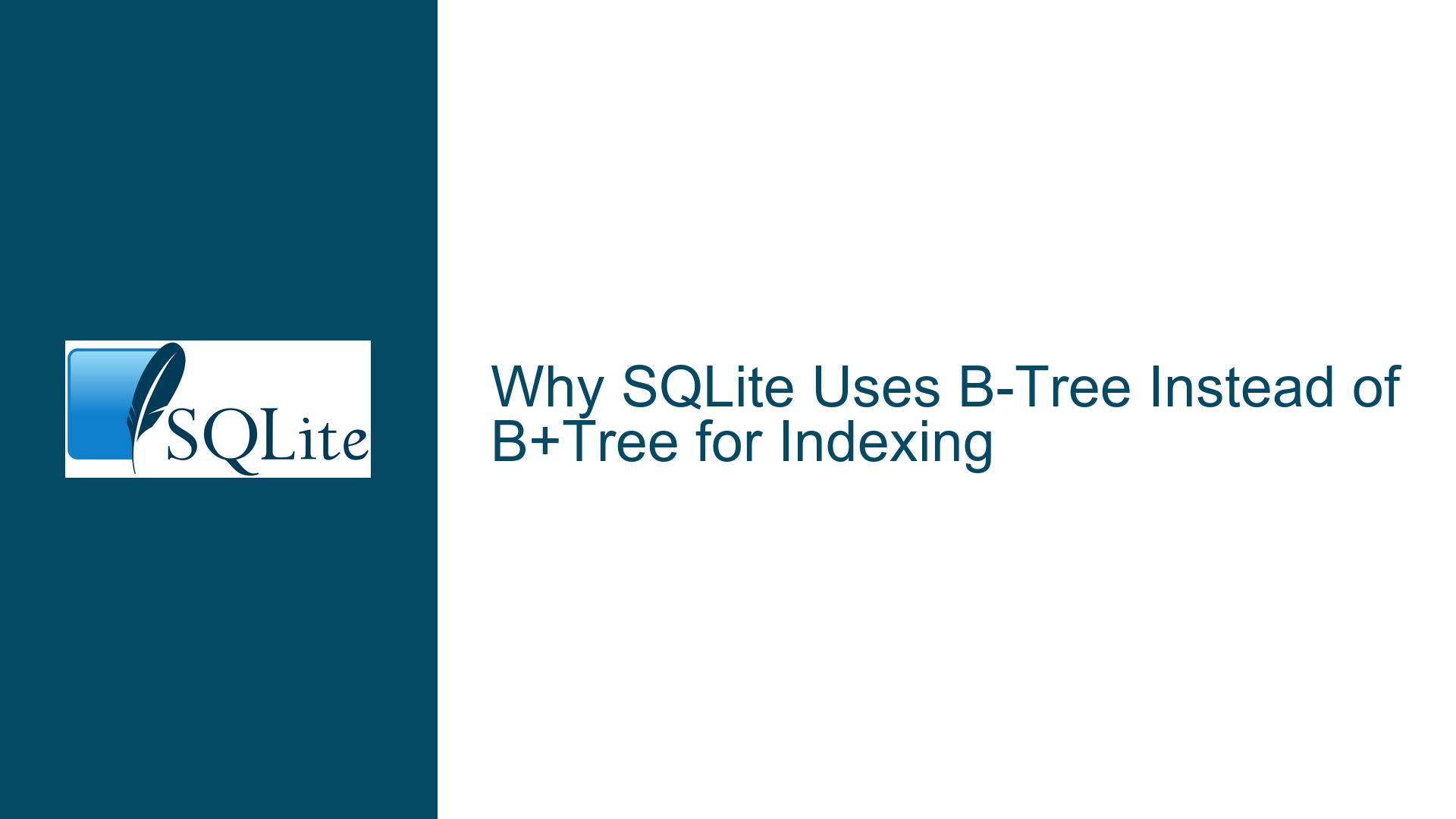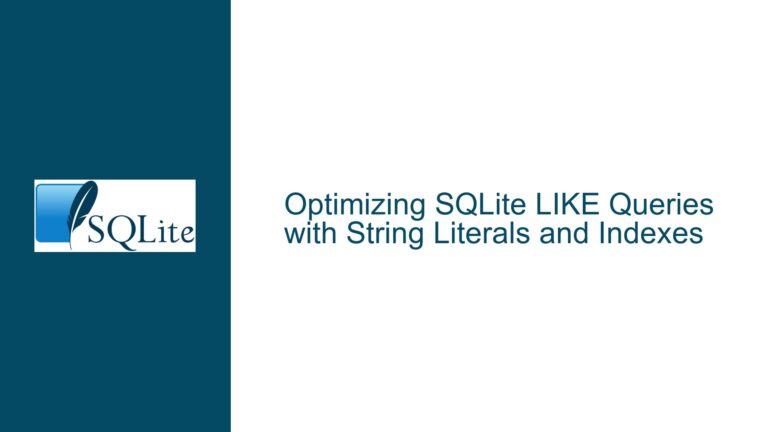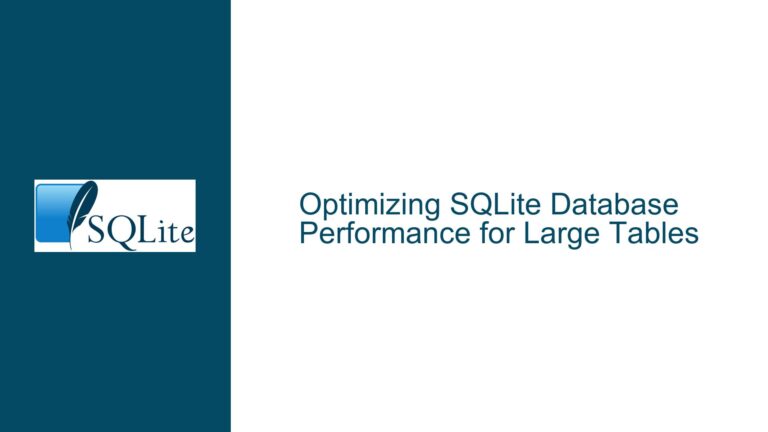Why SQLite Uses B-Tree Instead of B+Tree for Indexing
SQLite Indexing Mechanism and the Choice of B-Tree
SQLite, a widely-used embedded relational database management system, employs a B-tree data structure for its indexing mechanism. This choice is fundamental to how SQLite manages data retrieval, storage, and organization. Understanding why SQLite opts for B-trees over B+trees requires a deep dive into the architectural decisions, performance considerations, and the specific use cases that SQLite is designed to handle.
B-trees and B+trees are both balanced tree data structures that maintain sorted data and allow for efficient insertion, deletion, and search operations. However, they differ in how they store data and manage pointers to child nodes. In a B-tree, both keys and data are stored in all nodes, including internal nodes and leaf nodes. In contrast, a B+tree stores data only in the leaf nodes, with internal nodes acting solely as navigational structures to guide the search process.
The primary advantage of a B+tree is its efficiency in range queries. Since all data resides in the leaf nodes, which are linked together, traversing a range of values is straightforward and requires fewer disk I/O operations compared to a B-tree. This makes B+trees particularly suitable for databases that frequently perform range queries, such as those used in large-scale data warehousing applications.
However, SQLite’s use of B-trees is a deliberate design choice that aligns with its goals of simplicity, efficiency, and minimal resource consumption. SQLite is often used in environments where resources are limited, such as embedded systems, mobile applications, and IoT devices. In these contexts, the overhead of maintaining a B+tree’s additional structure may not justify the benefits, especially if range queries are not the primary use case.
Moreover, SQLite’s B-tree implementation is optimized for the types of operations it most frequently performs. SQLite’s primary use case is as an embedded database, where the database engine runs in the same address space as the application. This close integration allows SQLite to make certain assumptions about data access patterns and optimize accordingly. For example, SQLite often performs point queries—queries that retrieve a single row or a small number of rows based on a specific key. In such cases, the difference in performance between a B-tree and a B+tree is negligible, and the simpler B-tree structure is preferred.
Another factor influencing SQLite’s choice of B-trees is the need for transactional integrity. SQLite is designed to support ACID (Atomicity, Consistency, Isolation, Durability) transactions, even in environments where power failures or crashes may occur. The B-tree structure, with its ability to maintain balance and support efficient updates, is well-suited to this requirement. The B-tree’s ability to handle frequent insertions and deletions without significant degradation in performance is crucial for maintaining the integrity of the database during transactions.
In summary, SQLite’s use of B-trees instead of B+trees is a result of careful consideration of the database’s intended use cases, resource constraints, and performance requirements. While B+trees offer advantages in certain scenarios, particularly for range queries, the B-tree’s simplicity, efficiency, and suitability for transactional integrity make it the preferred choice for SQLite.
Performance Implications of B-Tree vs. B+Tree in SQLite
The choice between B-trees and B+trees has significant implications for database performance, particularly in terms of search efficiency, insertion and deletion operations, and range query performance. Understanding these implications is crucial for appreciating why SQLite opts for B-trees.
In a B-tree, each node contains both keys and data, which means that the tree’s height is generally lower compared to a B+tree of the same order. This lower height can lead to faster search times for point queries, as fewer nodes need to be traversed to reach the desired data. For SQLite, which often handles point queries in embedded environments, this can result in better overall performance.
However, the B-tree’s structure also means that data is distributed throughout the tree, which can lead to more complex and potentially slower range queries. In a B+tree, all data is stored in the leaf nodes, which are linked together. This linkage allows for efficient traversal of a range of values, as the search can simply follow the links between leaf nodes once the starting point is found. In contrast, a B-tree requires traversing multiple levels of the tree to retrieve all the data within a range, which can result in more disk I/O operations and slower performance.
Despite this, SQLite’s use of B-trees is justified by the fact that range queries are not the primary use case for many SQLite applications. In embedded systems and mobile applications, the database is often accessed in a more transactional manner, with frequent point queries and updates. In these scenarios, the B-tree’s efficiency in handling point queries and maintaining balance during insertions and deletions outweighs the potential drawbacks in range query performance.
Another performance consideration is the impact of insertions and deletions on the tree’s structure. Both B-trees and B+trees are designed to maintain balance, but the way they handle insertions and deletions can differ. In a B-tree, insertions and deletions may require more frequent splitting and merging of nodes, which can lead to more complex operations and potentially slower performance. However, SQLite’s implementation of B-trees includes optimizations to mitigate these issues, such as lazy deletion and node merging strategies that reduce the frequency of these operations.
In contrast, B+trees tend to handle insertions and deletions more efficiently, particularly in scenarios where data is frequently added or removed. The separation of keys and data in B+trees allows for more straightforward node splitting and merging, which can lead to better performance in high-update environments. However, this advantage is less relevant for SQLite, where the frequency of updates is often lower, and the focus is on maintaining transactional integrity and efficient point queries.
In conclusion, the performance implications of using B-trees versus B+trees in SQLite are closely tied to the database’s intended use cases and operational requirements. While B+trees offer advantages in certain scenarios, particularly for range queries and high-update environments, SQLite’s use of B-trees is optimized for the types of operations it most frequently performs, resulting in better overall performance for its target applications.
Optimizing SQLite Indexing for Specific Use Cases
Given SQLite’s use of B-trees for indexing, it is important to understand how to optimize the database for specific use cases, particularly in terms of query performance, storage efficiency, and transactional integrity. This section explores various strategies for optimizing SQLite indexing, taking into account the strengths and limitations of the B-tree structure.
One key strategy for optimizing SQLite indexing is to carefully design the schema and index structure to match the expected query patterns. For example, if the application primarily performs point queries on a specific column, creating an index on that column can significantly improve query performance. However, if the application frequently performs range queries, it may be necessary to consider alternative indexing strategies or even modify the schema to better support these queries.
Another important consideration is the choice of index type. SQLite supports several types of indexes, including single-column indexes, multi-column indexes, and unique indexes. Each type of index has its own advantages and trade-offs, and the choice of index type should be based on the specific requirements of the application. For example, a multi-column index can be more efficient for queries that filter on multiple columns, but it may also require more storage space and slower insertions and updates.
In addition to index type, the physical storage of the index can also impact performance. SQLite stores indexes as separate B-tree structures, which means that the size and organization of the index can affect query performance. One way to optimize index storage is to use the PRAGMA page_size and PRAGMA cache_size commands to adjust the page size and cache size of the database. Larger page sizes can reduce the number of disk I/O operations required for index traversal, while a larger cache size can improve the performance of frequently accessed indexes.
Another optimization strategy is to use covering indexes, which are indexes that include all the columns needed for a query. By using a covering index, the database can avoid the need to access the underlying table, resulting in faster query performance. However, covering indexes can also increase storage requirements and slow down insertions and updates, so they should be used judiciously.
Transactional integrity is another important consideration when optimizing SQLite indexing. SQLite’s support for ACID transactions means that the database must maintain consistency and durability even in the face of crashes or power failures. To ensure transactional integrity, SQLite uses a write-ahead log (WAL) and a rollback journal, which allow the database to recover from failures and maintain consistency. When optimizing indexes, it is important to consider the impact of these mechanisms on performance and to ensure that the database is configured to handle the expected workload.
Finally, it is important to monitor and tune the database performance over time. SQLite provides several tools for monitoring performance, including the EXPLAIN QUERY PLAN command, which can be used to analyze the execution plan of a query and identify potential bottlenecks. By regularly monitoring and tuning the database, it is possible to ensure that the indexing strategy remains effective as the application evolves.
In conclusion, optimizing SQLite indexing requires a careful balance between query performance, storage efficiency, and transactional integrity. By understanding the strengths and limitations of the B-tree structure and applying appropriate optimization strategies, it is possible to achieve optimal performance for a wide range of use cases. Whether the application primarily performs point queries, range queries, or a mix of both, careful schema design, index selection, and performance tuning can help ensure that SQLite meets the needs of the application.






